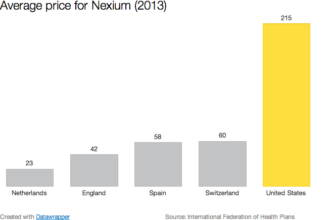Today in Health Affairs, Jishnu Das, Alaka Holla, Veena Das, Manoj Mohanan, Diana Tabak, and Brian Chan publish a unique and important study on the messy realities of health care in rural areas of the extremely poor state of Madhya Pradesh in India.
Today in Health Affairs, Jishnu Das, Alaka Holla, Veena Das, Manoj Mohanan, Diana Tabak, and Brian Chan publish a unique and important study on the messy realities of health care in rural areas of the extremely poor state of Madhya Pradesh in India.
Despite their relative poverty, the citizens of Madhya Pradesh seem to use health services at fairly high rates; more than half of households sent a household member to a primary care provider in the month prior to a household survey. Of these, 8% used a public provider when seeking care, while the rest go to providers in the private sector. But as the report demonstrates, once patients arrive at a primary care provider’s office, the situation becomes troubling.
Das et al build on work that was done as a background for the World Development Report 2004, which focused on making services work for poor people. They use a population-based sample of health care providers representative of the universe of primary care facilities –public and private- that serve rural households in rural Madhya Pradesh to assess quality of care. The authors employ an “unannounced standardized patient” –considered a gold standard in quality measurement- to present consistent cases of illness to providers and to report back on provider responses.
The study finds serious deficits in quality. Interactions between patients and providers were short (3.6 minutes on average) and the emphasis in both sectors was to give several medications to the patient as quickly as possible.
Across all cases, the correct treatment protocol was followed 30% of the time, while unnecessary or harmful treatment was prescribed or dispensed 42% of the time. Only one-third of providers articulated a diagnosis, correct or incorrect. When a diagnosis was issued, close to half were wrong, and only 12% were fully correct.
What’s going on?
Is it the lack of training of providers that explains these problems? About 67% of the sampled providers reported having no medical training at all; this figure was 63% in public clinics even though it is government policy to staff public clinics with a trained doctor. When analyzed further, provider qualifications did matter for quality, but the difference between qualified and unqualified providers explained only a small portion of the variation in quality measures, controlling for all other factors.
Was the infrastructure inadequate? Was caseload too heavy during the visit? Nope, neither factor had any significant association with any quality measure. In fact, the rural clinics were found to be relatively well-endowed in equipment and infrastructure.
The biggest difference in quality outcomes studied was explained by whether a provider was working in the private or public sector, with private providers demonstrating significantly higher performance on “percentage recommended questions and exams administered,” “giving any diagnosis,” and “giving correct treatment” even after controlling for differences in income, training and other variables.
What to do?
More and better trained human resources will likely help the situation, but the study begs the question: why would a policymaker want to expand supply in its status quo version when quality is so bad that 42% of prescribed treatments are unnecessary and even harmful?!
The woeful performance of even best trained providers suggests that provider motivation, affected by the incentive and accountability environment in which they operate, is a major obstacle to improving the quality and therefore the effectiveness of health care. Something about the private sector increases provider effort – perhaps it’s the minimal accountability relationship established by payment and desire for a return customer in a competitive environment? This was demonstrated earlier by Paul Gertler and Christel Vermeersch, in a “knowledge-quality efficiency gap,” which shows that providers need incentives in order to perform to the best of their knowledge (see figure below).
The Government of India is beginning to spend more on health. Yet its National Rural Health Mission plans for exclusively public sector solutions and relies on the traditional strategies of training, equipment and infrastructure to improve quality.
While we wait for new cadres of health professionals to be trained, where are the interventions that could make a difference for motivation given existing providers and actual patterns of patient use? And why is the messy reality of health care so hard to acknowledge and confront?







